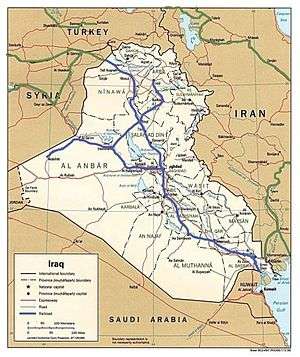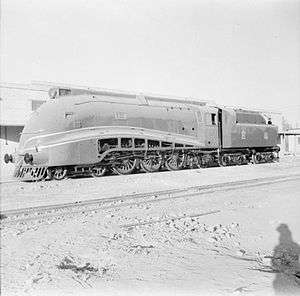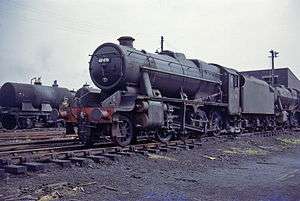Iraqi Republic Railways
| Government-owned corporation | |
| Industry | Rail transport |
| Founded | 1905 |
| Headquarters | Baghdad, Iraq |
| Products | Passenger Rail Transport |
| Website | www.scr.gov.iq |
| Iraqi Republic Railways | |
|---|---|
| Operation | |
| National railway | Iraqi Republic Railways Company |
| Track gauge | |
| Main | 4 ft 8 1⁄2 in (1,435 mm) standard gauge |
Iraqi Republic Railways Company (IRR) (Arabic: الشركة العامة لسكك الحديد العراقية) is the national railway operator in Iraq.
Network
IRR comprises 1,905 kilometres (1,184 mi) of 4 ft 8 1⁄2 in (1,435 mm) standard gauge. IRR has one international interchange, with Chemins de Fer Syriens (CFS) at Rabiya. The system runs from Rabiya southward through Mosul, Baiji, and Baghdad to Basra, with a branch line from Shouaiba Junction (near Basra) to the ports of Khor Az Zubair and Umm Qasr, westward from Baghdad through Ramadi and Haqlaniya to Al Qaim and Husayba, with a branch line from Al Qaim to Akashat, and east-west from Haqlaniya through Bayji to Kirkuk.
History
%22_-_DEX_FB_0033.jpg)
The first section of railway in what was then the Ottoman Empire province of Mesopotamia was a 123 kilometres (76 mi) length of the Baghdad Railway between that city & Samarra opened in 1914. Work had started northwards from Baghdad with the aim of meeting the section being constructed across Turkey & Syria to Tel Kotchek and an extension northwards from Samarra to Baiji was opened in December 1918.[1]
From 1916 onwards an invading British Military force brought narrow gauge equipment, firstly 2 ft 6 in (762 mm) gauge and later 1,000 mm (3 ft 3 3⁄8 in) metre gauge gauge from India to Southern Mesopotamia to construct various sections of line to support its offensive against the Turks. Britain defeated the Ottomans and Mesopotamia became a League of Nations mandate under British administration. In April 1920 the British military authorities transferred all railways to a British civilian administration, Mesopotamian Railways.[2]
The metre gauge line from Basra to Nasiriyah was the most important section constructed during the war in terms of its significance as part of later efforts to construct a national railway network. Soon after the end of World War I this was extended northwards from Ur Junction outside Nasiriyah up the Euphrates valley with the complete Basra to Baghdad route being opened on 16 January 1920.[3]
The other section of metre gauge line built during World War I that had ongoing significance was that from Baghdad East north eastwards to the Persian border. After the war the eastern end of this line was diverted to Khanaqin and the wartime built line north west from Jalula Junction was extended from Kingerban to Kirkuk in 1925.[3]
In 1932 Iraq became independent from Britain. In March 1936 Britain sold Mesopotamian Railways to Iraq, which renamed the company Iraqi State Railways.[2] Work resumed on the extension of the Baghdad Railway between Tel Kotchek on the Syrian frontier and Baiji. The through route was opened and completed on 15 July 1940.[2] In 1941 the Iraqi State Railways PC class 4-6-2 steam locomotives were introduced to haul the Baghdad — Istanbul Taurus Express on the Baghdad Railway between Baghdad and Tel Kotchek.[4] From 1941 onwards the UK War Department supplemented ISR's locomotive fleets: the metre gauge with HG class 4-6-0s requisitioned from India[5] and new USATC S118 Class 2-8-2's from the USA,[6] and the standard gauge with new LMS Stanier Class 8F 2-8-0s[7] and USATC S100 Class 0-6-0T's.[8]

In 1947 the Iraq Petroleum Company opened a branch at Kirkuk, which it operated with its own Hudswell Clarke 2-8-4T's from 1951.[9][10] ISR opened a new metre gauge line from Kirkuk to Arbil in 1949. A joint road & rail bridge was opened across the River Tigris in Baghdad in 1950, finally connecting the east and west bank metre gauge systems.[2] ISR added new steam locomotives in the 1950s: 20[11] metre gauge 2-8-2's from Ferrostaal of Essen and 10[12] from Vulcan Foundry[13] in 1953 and 20 more[14] from Maschinenfabrik Esslingen[15] in 1955-56 and 2-8-0s from Krupp, plus standard gauge 2-8-0s also from Krupp.[16][17]
In 1958 when Iraq's Hashemite monarchy was overthrown and a republic declared, ISR was renamed Iraqi Republic Railways.[2] In 1961 IRR began to replace its standard gauge steam locomotive fleet with diesels from ČKD[18][19][20] and ALCo.[21][22] In 1972 several classes of steam locomotive were still in service on the standard gauge system,[23][24] but these were replaced by further classes of diesel from Alstom, Montreal Locomotive Works and MACOSA.[22] IRR did not begin to replace its metre gauge steam locomotives until after 1983.[2][25]
In 1964 IRR extended its standard gauge network with a line from Baghdad to Basrah which opened for freight in 1964 and for passengers in 1968. It has since been extended from Shouaiba Junction to the port of Umm Qasr.[2]
From 1980 until 2003 IRR suffered approximately one billion United States dollars' worth of war and looting damage.[26]
Passenger services
In around October 2008, a commuter service resumed between Baghdad Central and the southern suburb of Doura.[27] There is a nightly service between Baghdad and Basra and a Friday-only pilgrims service to Samarra. In March 2009, a weekly service started between Baghdad and Fallujah. The Baghdad - Mosul line is almost ready for passenger services to resume. Transport Minister Abdul Jabbar Ismail said that he hoped to extend the existing network of 1,243 miles (2,000 km) to between 2,485 miles (3,999 km) and 3,107 miles (5,000 km) but that there were obstacles such as budget restraints and contract approvals.[28] CSR Sifang Co Ltd. is supplying 10 new 99 miles per hour (159 km/h) trains in 2014.[29]
Rolling stock
Current (information partly from 2004)
| Class | Image | Axle Formula | Number | Year in Service | Power [hp] |
Constructor | Notes | |
|---|---|---|---|---|---|---|---|---|
| DHS 101-3BB | Bo-Bo | 3 | 1986 | 600 | Nippon Sharyo | Not in service anymore[30] | ||
| DHS 111-3BB | Bo-Bo | 3 | 1973 | 600 | Nippon Sharyo | Not in service anymore[30] | ||
| DHS 121-7BB | Bo-Bo | 7 | 1982 | 600 | Nippon Sharyo | Not in service anymore[30] | ||
| DHS 131-144 | Bo-Bo | 14 | 2002-'03 | 1000 | Tülomsas | 8 in service in 2004[30] | ||
| DEM 2001-2010 | Co-Co | 10 | 1963 | 1650 | ČKD | 5657 - 5766. Not in service anymore[30] | ||
| DEM 2011-2020 | Co-Co | 10 | 1964 | 1650 | ČKD | 5802 - 5811. Not in service anymore[30] | ||
| DEM 2101-2105 | Co-Co | 5 | 1965 | 2000 | Alco | 3416.01-3416.05. Not in service anymore[30] | ||
| DEM 2201-2220 | Co-Co | 20 | 1971 | 2000 | Alsthom | Not in service anymore[30] | ||
| DEM 2301-2330 | Co-Co | 30 | 1975 | 2000 | Montreal LW | 6083.01-6083.30. Not in service anymore[30] | ||
| DEM 2331-2361 | Co-Co | 30 | 1976 | 2000 | Montreal LW | 6093.01-6093.31. Not in service anymore[30] | ||
| DEM 2401-2455 | Co-Co | 55 | 1980 | 2000 | Macosa | 1631-1685. Some maybe in service[30] | ||
| DEM 2501-2582 | Co-Co | 82 | 1983 | 2250 | Henschel | 32711-32720, 32639-32710. Seen in service in 2007. 2559-2561 were formerly dedicated to Saddam Hussein’s private passenger train.[30] | ||
| DEM 2701-50 |  |
Bo-Bo | 50 | 2001 | 2000 | Dalian | In service[30] | |
| DEM 2801-30 | Co-Co | 30 | 2004 | 2630 | Lugansk | Some maybe in service[30] | ||
| DES 3001-36 | Bo-Bo | 36 | 1962-'73 | 650 | ČKD | [30] | ||
| DES 3101-200 |  |
Co-Co | 100 | 1979-'81 | 1100 | ČKD | 11301-11303, 12204-12211, 12272-12360[30] | |
| DES 3301-6 | Bo-Bo | 6 | 2004 | 1200 | Bryansk | [30] | ||
| DEM 4001-11 | Co-Co | 11 | 1980 | 3600 | Francorail | [30] | ||
| DEM 4101-61 | Co-Co | 6 | 1980-'82 | 3600 | Francorail | [30] | ||
| DMU | 10 | 2014 | 3600 | CSR | 160 km/h. 10-car long-distance train has two power cars and accommodates up to 343 passengers intended for Bagdad - Basra. | |||
| * DHS = Diesel-hydraulic, DEM = Diesel-electric | ||||||||
Retired
| Class | Image | Axle Formula | Number | Year in Service | Power [kW] |
Constructor | Notes |
|---|---|---|---|---|---|---|---|
| HJ Class | 4-6-0 | 203 | 1902 | Originally built for Bengal and North Western Railway. Exported to Iraq in Second World War. [31] | |||
| HG Class | 4-6-0 | 1907 | Robert Stephenson | One seen as 132 in 1967. Originally built for Burma Railways. Exported to Iraq later. [31] | |||
| HG Class | 4-6-0 | 1920 | Nasmyth Wilson | One seen as 179 in 1967. Originally built for South Indian Railway Company. Exported to Iraq later. [31] | |||
| HG Class | 4-6-0 | 1923 | North British | One seen as 193 in 1967. Originally built for South Indian Railway Company. Exported to Iraq later. [31] | |||
| HGS Class | 4-6-0 | 1921 | Vulcran Foundry | One seen as 149 in 1967. Exported to Iraq later. [31] | |||
| NA Class | 4-8-0 | 226 | 1920 | North British | Originally built for Madras and Southern Mahratta Railway. Exported to Iraq in Second World War. [31] | ||
| ? | 0-6-0 | ? | 1912 | Borsig | One photographed in 1967 on display at Baghdad West Railway station.[31] | ||
| ? | 0-4-0VBT | ? | 1928 | Sentinel | Two photographed in 1967 as RM2/RM3.[31] | ||
| PC class |  |
4-6-2 | 4 | 1941 | Robert Stephenson and Hawthorns | Series 501-504. Built in 1940. 504 lost during transport to Iraq. Out of service in 1967. | |
| TD Class |  |
2-8-0 | 12 | 1942 | NBL | 143 Sent to Iran after 1941 Anglo-Soviet invasion. Ten were purchased by I.R.R. in 1947, two in 1948. Operated until the seventies. 1 Currently possible disused - abandoned in field near IRR 33°20′43.20″N 44°21′13.90″E / 33.3453333°N 44.3538611°E. Series around 1400. War departement 70746> 1402 | |
| SA Class | 0-6-0 | 5 | 1942-'44 | Davenport | Series 1211-1215. In 1967 at least two active. According to some they were used by Palestine Military Railway first. P.M.R. 106 > 423, 165 > 425, 404 > 429, 406 > 430, 434 > 431, 437 > 432, 512 > 438.[32] | ||
| V | 0-4-0T | 1910 | Borsig | One seen as 208 in 1967 on display in Shalchiyah. | |||
| W | 2-8-2 | 1943 | Alco | One seen as 63 in 1967. | |||
| 2-8-4T | 1951 | Hudswell Clarke | |||||
| Y | 2-8-2 | 10 | 1953 | Vulcan Foundry | One seen as 80 in 1967 | ||
| Z | 2-8-2 | 1956 | Esslingen | One seen as 96. |
Developments
Iraq-Syria Direct Railway Link
Syrian Railways had been extending a rail route from Deir ez-Zor Junction towards the modern Husaibah branch terminus on the Iraqi side of the border, which was built as a through station. The route follows the Euphrates river valley and Google Earth shows the route complete to within 30 kilometres (19 mi) of the border, but requiring a major bridge across the river. This route would be more direct than the existing one via the border station at Tall Kushik.
Iraq-Jordan Direct Railway Link
In August 2011, Jordanian government approved the construction of the railway from Aqaba to the Iraqi border (near Traibil). The Iraqis in the meantime started the construction of the line from the border to their current railhead at Ramadi.[33]
High-speed Baghad-Basra line
A 650 km (400 mi) 250 km/h (155 mph) line between Baghdad and Basra was planned, with the Iraqi Railways and Alstom in discussions.[34]
Although not true high-speed rail, it operates since 2014. New trainsets for use on the Baghdad-Basra route were unveiled in China in February 2014 before being shipped to Iraq.[35]
Couplings
IRR uses Soviet-style SA3 automatic couplers. In order to allow interchange with CFS and Turkish State Railways which both use screw couplers, IRR locomotives and most wagons are equipped with screw couplings and buffers. In Iraqi service the buffers do not make contact and the screw couplings hang down unattached. The railways in adjoining Saudi Arabia use American type Janney automatic couplers. There is currently no rail link planned to Saudi Arabia.
Rail links to adjacent countries
- Iran - one link partially under construction and a second link planned
- Khorramshahr, Iran, to Basra, Iraq - almost complete (2006)
- Kermanshah, Iran, and the Iraqi province of Diyala - construction commenced. See ([36]) or 2005.
- Jordan - partially constructed - break of gauge 4 ft 8 1⁄2 in (1,435 mm) standard gauge/1,050 mm (3 ft 5 11⁄32 in) gauge
- Syria - same gauge - at Rabiaa/al-Ya'rubiya
See also
References
- ↑ Hughes (1981) p. 87
- 1 2 3 4 5 6 7 Hughes (1981) p. 90
- 1 2 Hughes (1981) p. 89
- ↑ Hughes (1981) p. 98
- ↑ "Iraq Narrow Gauge Railways photo gallery". 20 November 2008. Archived from the original on 20 November 2008.
- ↑ "Iraq Narrow Gauge Railways photo gallery". 20 November 2008. Archived from the original on 20 November 2008.
- ↑ "The Restoration & Archiving Trust: Image no. br670616".
- ↑ "Iraq Standard Gauge Railways photo gallery". 20 November 2008. Archived from the original on 20 November 2008.
- ↑ "Iraq Narrow Gauge Railways photo gallery". 20 November 2008. Archived from the original on 20 November 2008.
- ↑ "The Restoration & Archiving Trust, Image no. br670534".
- ↑ "Steam locomotives in Iraq - Railways of Iraq". www.andrewgrantham.co.uk.
- ↑
- ↑ "Iraq Narrow Gauge Railways photo gallery". 20 November 2008. Archived from the original on 20 November 2008.
- ↑ "Iraq Railways - Iraqi State Railways 2-8-2 Class Z steam locomotive Nr. 91 (MF Esslingen, 1955/6)".
- ↑ "Iraq Narrow Gauge Railways photo gallery". 20 November 2008. Archived from the original on 20 November 2008.
- ↑ "Iraq Standard Gauge Railways photo gallery". 20 November 2008. Archived from the original on 20 November 2008.
- ↑ "Iraq Standard Gauge Railways photo gallery". 20 November 2008. Archived from the original on 20 November 2008.
- ↑ "Iraq Standard Gauge Railways photo gallery". 20 November 2008. Archived from the original on 20 November 2008.
- ↑ "Iraq Standard Gauge Railways photo gallery". 20 November 2008. Archived from the original on 20 November 2008.
- ↑ "Iraq Standard Gauge Railways photo gallery". 20 November 2008. Archived from the original on 20 November 2008.
- ↑ "Iraq Standard Gauge Railways photo gallery". 20 November 2008. Archived from the original on 20 November 2008.
- 1 2 Hughes (1981) p. 97
- ↑ "World Railways Photograph Catalogue - Restoration & Archiving Trust". gwrarchive.org.
- ↑ "Taurus Express 1972".
- ↑ "World Railways Photograph Catalogue - Restoration & Archiving Trust". www.gwrarchive.org.
- ↑ David White (1 March 2004). "Rebuilding Iraq's ravaged railways". Railway Gazette International. Retrieved 9 September 2007.
- ↑ "All Aboard the Baghdad Metro", Los Angeles Times, 18 November 2008
- ↑ "Iraq's Struggle to get railway back on track after neglect and war", The Times, 14 April 2009
- ↑ "Iraqi inter-city train rolled out". Railway Gazette International. 25 February 2014.
- 1 2 3 4 5 6 7 8 9 10 11 12 13 14 15 16 17 18 19 HaRakevet: Rothschild PhD, Rabbi Walter (March 2005), I.R.R. Diesel loco stocklist. Series 18 issue 68
- 1 2 3 4 5 6 7 8 "World Railways Photograph Catalogue - Restoration & Archiving Trust". gwrarchive.org.
- ↑ HaRakevet: Rothschild PhD, Rabbi Walter (September 1989), Palestine Military Railways Ex-LSWR 0-6-0's Series 2 issue 5
- ↑ Construction begins on 500km Jordan-Iraq railway, Construction Week, 24 August 2011
- ↑ "Alstom in deal to build high-speed rail in Iraq". www.telegraph.co.uk. The Telegraph. 26 June 2011.
- ↑ "New Iraqi inter-city train rolled out". Railway Gazette. 25 Feb 2014. Retrieved 1 March 2014.
- ↑ Archived 26 April 2008 at the Wayback Machine.
Sources
- Hughes, Hugh (1981). Middle East Railways. Continental Railway Circle. pp. 87–99. ISBN 0-9503469-7-7.
External links
| Wikimedia Commons has media related to Rail transport in Iraq. |
- "Iraq Railways", www.iraqrailways.com , general information
- "Iraq Railway Network" (PDF), www.ajg41.plus.com, United Nations Joint Logistics Centre UNJLC, 22 May 2005, archived from the original (PDF) on 4 April 2007 , map of railway routes in Iraq
- Andrew Grantham, "Railways in Iraq - an unofficial site", www.andrewgrantham.co.uk
- "Photo Gallery - Iraqi Republic Railways Co.", www.on-track-on-line.com, On Track On Line
- Rainer Fuchs, "Rainer's Iraq Railway Stamps Pages", fuchs-online.com
- "The Railways of Iraq", www.gwrarchive.org, The Restoration & Archiving Trust, archived from the original on 12 June 2009
- Iraq Railways Photos on YouTube
- Basic technical specifications of Iraqi standard and metre gauge steam locomotives
- Map of Iraq railways in 2009 drawn by Joseph Redford
- Taurus Express -- information on passenger trains in Turkey and Iraq from Werner and Hans Soelch's Trains-WorldExpresses site
- Taurus Express 1972 -- photos from a trip through Turkey and Iraq in 1972
- Louis Culshaw's photos of MG steam in 1982